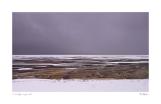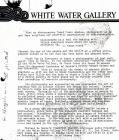1
Michael De Morée, the eldest of four children, was born in 1940 in Geertruidenberg, the Netherlands. He was raised in Breda, the Netherlands.He studied photography at St. Joost Art College, a school that his father co-founded in 1947. He began his diploma in 1957 and graduated in 1962.
He married Marianne Kouters in 1966 and they moved to Toronto, Ontario. He initially worked as a photojournalist for news photographer, Jim Lynch. He taught photography at Humber College in Toronto from 1968 to 1969. In 1970, they moved to North Bay, Ontario, where he taught photography in the graphic communications and journalism programs from 1970 to 2000.
Michael's works are in private and corporate collections, including North Bay City Hall, Ontario Northland and the Ontario Lottery and Gaming Corporation.
(The biographical information featured here was written in consultation with the artist in 2006.)
Interview:
PHOTOGRAPHER HAS A PASSION FOR LANDSCAPES SNAPSHOTS
Photographer Michael De Morée has an eye for the natural landscape. The landscape photographer originally came to northern Ontario from a highly urban environment in Europe where his photographic interest, earlier in his career, was people. But once he came to the very natural environment in northern Ontario, his interests changed to landscapes.
At 17 years of age, De Morée knew he wanted to be a photographer. But before then, De Morée couldn't recall a specific time in his life where he knew he wanted to become an artist.
"My father was an artist so I grew up surrounded by art and artists," De Morée added.
De Morée is interested in a wide variety of subjects but his photographic ideas come from observing life and the world around him. "I am greatly influenced by where I live and work," De Morée said.
De Morée feels that photography is the easiest discipline but also the most difficult one. "Anybody can take a picture," De Morée added. "But few people can create a truly memorable image."
De Morée's work reflects personal experience, art and books. "Of course, a great influence is the area where I live and where I travel," De Morée said.
When taking landscape photos, De Morée has a lot to ponder in order to get the most beautiful image possible.
He explained that the first thing he does when taking a photo is decide the right lighting for the image. Once the lighting has been established, he then decides if the photograph should be taken in sunlight or not. He then considers the right time of day to take the photo and which season will produce the best image.
"Is it better in the winter, a season which gives strong graphic images or is the summer better?" De Morée asked.
Another decision is whether the picture should be in black and white or colour.
"I make decisions when I take the image," De Morée said. "But when I return home to my studio and look at the raw images, I will sometimes change my mind."
De Morée believes every photograph taken, including his, have stories behind them.
"Photography is closer to literature, especially poetry, than to any other art form," De Morée said.
De Morée is clueless as to where his photographic passion comes from. "All I know is if I don't take at least one picture every day and work and think about photography then it is not a good day," De Morée expressed. "Photography is in me and is simply part of my life."
De Morée said every picture poses its own problems and because of those problems, every image taken is a struggle for perfection. But when it comes to the final product, De Morée believes once a picture is completed, then the picture is in the past. "I rarely look back at what I have done before," De Morée said. "It is the new work which absorbs you."
De Morée enjoys every aspect of making an image. "Everything is very satisfying to me," he added.
The amount of time De Morée invests is different for every picture as it depends on the subject and the image itself. He said sometimes after he takes a picture, it might take him a few days before he decides to continue working on it. He calls this time frame the gestation period - the time to reflect on what the image should look like. "Other times, I start straight away to work on the pictures," De Morée said. "So it all depends on how I feel about the subject."
While taking his pictures, De Morée doesn't consciously instill emotion in his work but knows that in order for the picture to be good, it has to express some sort of emotion.
"That is what art is all about," De Morée expressed.
(By Andrew Hopkins, based on an interview in 2006).



